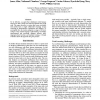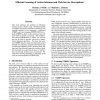AAAI
2008
14 years 1 months ago
2008
We describe a novel integration of Planning with Probabilistic State Estimation and Execution resulting in a unified representational and computational framework based on declarat...
AAAI
2007
14 years 1 months ago
2007
Recently defined resolution calculi for Max-SAT and signed Max-SAT have provided a logical characterization of the solving techniques applied by Max-SAT and WCSP solvers. In this...
AAAI
2008
14 years 1 months ago
2008
We present the first planner capable of reasoning with both the full semantics of PDDL2.1 (level 3) temporal planning and with numeric resources. Our planner, CRIKEY3, employs heu...
AAAI
2008
14 years 1 months ago
2008
We present a new algorithm for reasoning in the description logic SHIQ, which is the most prominent fragment of the Web Ontology Language OWL. The algorithm is based on ordered bi...
AAAI
2007
14 years 1 months ago
2007
To be effective, an agent that collaborates with humans needs to be able to learn new tasks from humans they work with. This paper describes a system that learns executable task m...
AAAI
2008
14 years 1 months ago
2008
Probabilistic modeling has been a dominant approach in Machine Learning research. As the field evolves, the problems of interest become increasingly challenging and complex. Makin...
AAAI
2008
14 years 1 months ago
2008
This work addresses the problem of efficiently learning action schemas using a bounded number of samples (interactions with the environment). We consider schemas in two languages-...
AAAI
2007
14 years 1 months ago
2007
bstract or nonliving entities act or are described as living. And living things gain extra benefits such as animals talking. For this reason, the standard scripts are modified to a...
AAAI
2008
14 years 1 months ago
2008
Agents often have to construct plans that obey resource limits for continuous resources whose consumption can only be characterized by probability distributions. While Markov Deci...
AAAI
2007
14 years 1 months ago
2007


